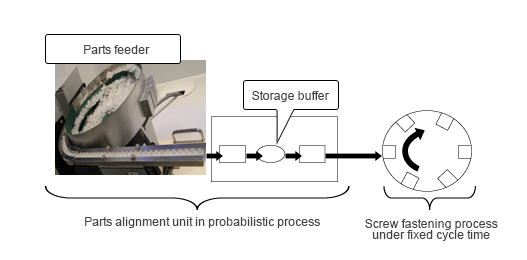#325 Know-how on automation: Automating screw fastening - 3: Screw feeding errors and countermeasures
This section describes screw parts feeding errors, the second commonest cause for troubles in automating screw fastening.
(1)Screw parts feeding errors and causes for the troubles
・Approximately 50% of troubles in automating screw fastening is accounted for by screw fastening failures from the previous discussion and screw parts feeding errors in the current section.
・Factors such as various screw shapes (screw diameter, length, special type of screw, with or without washer, etc.) being used, or the processing cycle being rather short are also causes for errors.
・A variety of screw parts are listed below.
・Besides the variety of screws, burrs formed in the outer region due to a difference in the processing method, and variations in screw quality per production lot are sometimes convincing causes for the trouble.
![[Fig. 1] Variety of screw parts [Fig. 1] Variety of screw parts](/tt/en/lca/D544_01.gif)
・Fig. 2 shows a typical distribution data representing factors for screw parts feeding errors.Factors causing the problems, based on the data in the figure, can roughly be classified into three categories: (1) feeding mechanism (parts feeder, feeding pipe/chute), (2) screw clamp mechanism, (3) screw parts quality
![[Fig. 2] Data for distribution of factors for screw parts feeding errors [Fig. 2] Data for distribution of factors for screw parts feeding errors](/tt/en/lca/D544_02.gif)
(2)Screw parts and difficulty in feeding
・From such a wide variety of screw parts (Fig. 1), you could easily imagine it is hard to keep stable feeding of screw parts.
・Differences in screw appearance fluctuate "center of gravity" or "friction characteristics" which greatly affect the feeding orientation. Lower cost screws may sometimes have problems like burrs, magnetization, etc.
・Screws with washers may become foreign substances due to "entanglement" or disengagement of the washer, which makes countermeasures more complex.
・In the case of Fig. 3-a), the screw orientation during transport and the screw fastening direction after the transport are matched, which requires no inversion of screw orientation. But, this increases a risk that "jamming" may occur in the bending section of the feeding pipe, since the center of gravity is backward against the transport direction.
・In the case of Fig. 3-b), the orientation needs to be reversed before the screw fastening process, although the stability of orientation is good during the transport.
![[Fig. 3] Example of screw orientation and difficulty in feeding [Fig. 3] Example of screw orientation and difficulty in feeding](/tt/en/lca/D544_03.gif)
・Since entry of foreign substances is involved both in the first and the third commonest causes for feeding errors shown in Fig. 2, the countermeasures for avoiding such entry is extremely effective. Following are some examples:
a) Inspection for entry of foreign substances at receiving inspection (automatic selection, etc.)
b) Double selection design during automation process
(3)Importance in design of feeding system
・Automation of screw fastening requires both high productivity and reliability at the same time.
・An automation process consists of a screw alignment feeding unit, and a screw fastening unit. In the former unit, alignment of parts is based on a probabilistic process since it involves the parts feeder.The screw fastening unit, on the other hand, involves a process at a fixed cycle.
・It is desirable to have a storage buffer for storing screws for alignment in order to connect these two units with different process cycles.

- Positioning technology
- Designing and processing
- Sensor Technology
- Automation elements technology
- Clean room technology
- Design hints
- Design tips
- Designing and Machining
- Drive mechanism design
- Hints on designing
- Linear Motion Components
- Locating Technology
- Manufacturing technology
- Motion mechanism design
- Pneumatic Drives
- Production Technology
- Technology Outlook
- General description
- Low-cost automation and materials
- Transfer LCA
- #333 Know-how on automation: Pressurized heating technology - 5: Multilayer pressurized heating process technique
- #332 Know-how on automation: Pressurized heating technology - 4: Points to remember when designing mechanism of pneumatic pressurization method
- #331 Know-how on automation: Pressurized heating technology - 3: Pneumatic pressurization method and pressure profile
- #330 Know-how on automation: Pressurized heating technology - 2: Pressurization method and pressure profile
- #329 Know-how on automation: Pressurized heating technology



